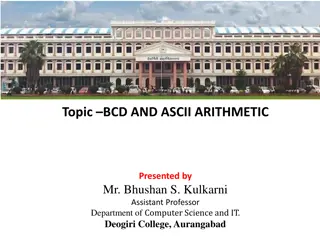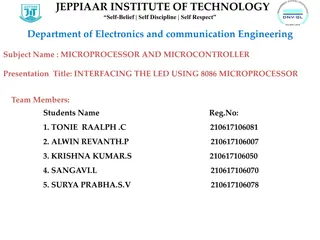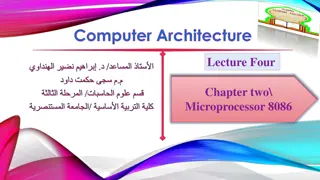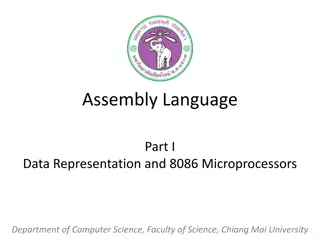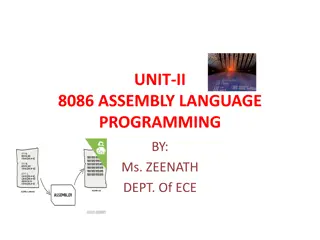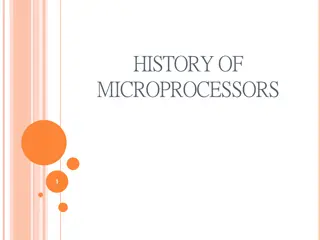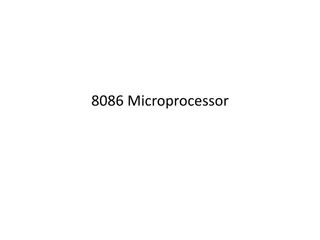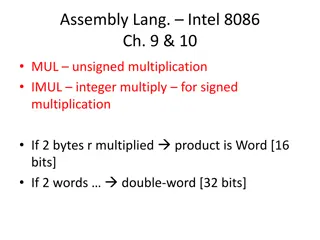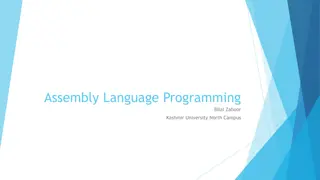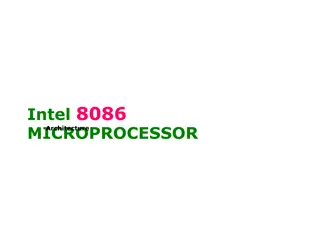BCD and ASCII Arithmetic in 8086 Assembly Language
BCD (Binary-Coded Decimal) and ASCII (American Standard Code for Information Interchange) are key concepts in 8086 assembly language for numerical and character manipulations. BCD Arithmetic involves addition and subtraction techniques using instructions like DAA and DAS. The adjustment instructions
1 views • 21 slides
Introduction to Intel Assembly Language for x86 Processors
Intel Assembly Language is a low-level programming language designed for Intel 8086 processors and their successors. It features a CISC instruction set, special purpose registers, memory-register operations, and various addressing modes. The language employs mnemonics to represent instructions, with
2 views • 12 slides
Interfacing the LED with 8086 Microprocessor - JEPPIAAR INSTITUTE OF TECHNOLOGY
Explore the process of interfacing an LED with the 8086 Microprocessor at JEPPIAAR INSTITUTE OF TECHNOLOGY. Learn about the 8086 Microprocessor, its features, Trainer Board, and the steps involved in the LED interfacing. Discover the internal architecture and operation of the 8086 Microprocessor thr
1 views • 12 slides
Flag Registers in Microprocessor 8086
This content discusses the flag registers in the Microprocessor 8086, covering conditional flags such as Carry Flag (CF), Auxiliary Flag (AF), Parity Flag (PF), Zero Flag (ZF), Sign Flag (SF), and Overflow Flag (OF), as well as control flags including Trap Flag (TP), Interrupt Flag (IF), and Directi
1 views • 23 slides
Assembly Language and 8086 Microprocessors
Dive into the world of Assembly Language, data representation, and 8086 microprocessors. Explore topics like memory organization, integer representation, and computer registers. Learn about the structure and functionality of machine language instructions, as well as the convenience of using assembly
4 views • 36 slides
Introduction to 8086 Assembly Language Programming
Assembler directives play a crucial role in guiding the assembly process for 8086 assembly language programming. They dictate how operands are handled, memory organization, and more. This content covers essential directives such as ASSUME, DB, DW, DD, DQ, and DT, providing syntax examples and explan
4 views • 29 slides
Evolution of Microprocessors: A Historical Overview
The history of microprocessors traces back to Fairchild Semiconductors in 1959, leading to the founding of Intel in 1968. The evolution from 4-bit to 64-bit microprocessors by Intel revolutionized computing. Key milestones include the Intel 4004 and 4040 (4-bit), 8008, 8080, and 8085 (8-bit), and th
5 views • 44 slides
The Functional Blocks of the 8086 Microprocessor
The 8086 Microprocessor is a pivotal component in computer systems, with various functional blocks storing results as status bits called flags in the flag register. It performs arithmetic and logic operations, utilizes registers for data storage, features an ALU for generating addresses and instruct
4 views • 41 slides
Overview of 8086 Assembly Language Arithmetic Operations
The 8086 assembly language provides instructions for arithmetic operations such as addition, subtraction, and comparison. These operations are essential for manipulating data in memory and registers. The instructions support various operand types, including registers, memory locations, and immediate
3 views • 24 slides
Addressing Modes in 8086
Delve into the world of addressing modes in the 8086 processor to comprehend how different types of operands are accessed and utilized during instruction execution. Explore immediate, direct, register, register-indirect, and other addressing modes with detailed examples.
1 views • 17 slides
Assembly Language Programming in Intel 8086: Multiplication, Division, and Array Handling
Assembly language programming in Intel 8086 involves operations like unsigned and signed multiplication using MUL and IMUL instructions, respectively, along with division using DIV and IDIV instructions. This programming also encompasses handling arrays through the use of DUP to define arrays with c
3 views • 10 slides
Evolution of Intel Microprocessors: From 4004 to Pentium 4
Explore the history of Intel microprocessors, from the groundbreaking 4004 and 8008 to the evolution of 16-bit and 32-bit processors like the 8086 and the Pentium 4. Discover how Moore's Law has driven advancements in transistor count and processing capabilities in the world of microprocessors.
0 views • 39 slides
Overview of Intel 8086 Microprocessor and Internal Architecture
Intel 8086 microprocessor is a vital component in electronics, with an internal architecture comprising BIU and EU. The BIU handles bus operations, instruction fetching, and address calculation, while the EU executes instructions from the instruction queue. The pin diagram and internal architecture
0 views • 19 slides
Overview of Assembly Language Programming in 8086 Architecture
Assembly language programming in the 8086 architecture involves writing case-sensitive instructions represented by statements. Each statement corresponds to an 8086 instruction or an assembler directive. Instructions follow a specific format with optional components like labels and comments. Assembl
0 views • 31 slides
Evolution of Intel x86 Processors
Intel's x86 processor series began with the 8086 in 1982 and evolved through the 80186, 80286, 386DX, 386SX, and 386EX models, each offering advancements in performance, addressing, and data capabilities. These processors played a pivotal role in the development of desktop computing, with features s
0 views • 38 slides
8086 Architecture and Binary Numbering System
Explore the fundamentals of 8086 architecture and binary numbering system. Delve into how computers interpret binary digits, the significance of bits, nibbles, bytes, words, and double words, and the conventions for denoting binary numbers. Learn binary addition and subtraction with examples.
0 views • 6 slides
Intel 8086 Microprocessor Architecture Overview
The Intel 8086 microprocessor is a 16-bit processor with a 20-bit address bus capable of accessing up to 1MB of memory. It features 14, 16-bit registers, multiplexed address, and data bus, segmented memory architecture, and dedicated units for instruction execution and bus interface. Learn about its
0 views • 40 slides
